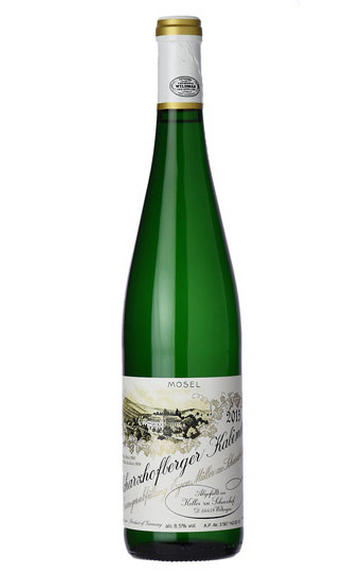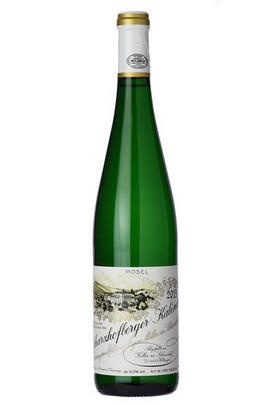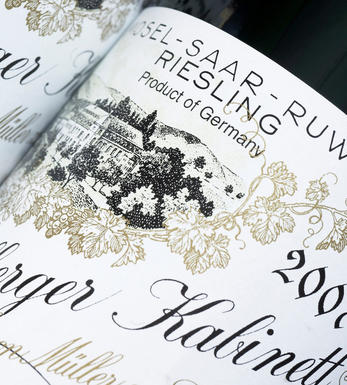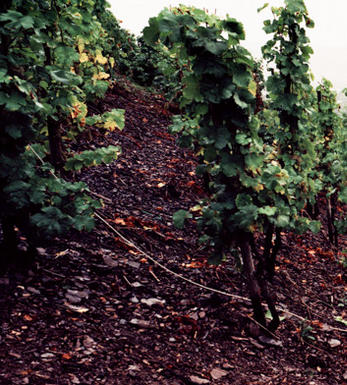
2009 Riesling, Kabinett, Scharzhofberger, Egon Müller, Mosel, Germany

Critics reviews
While Egon Muller harvested into November, he noted that the best results were mostly achieved before that, with "the Spatlesen and Auslesen picked in the early passes, which captured what there was of botrytis" on his vineyards, and the collection he fielded from 2009 is not merely notable for the extraordinary quality of select cuvees, but also for its outstanding consistency.
Muller draws parallels with 1971, 1990, and 1997, while noting that his 2009s are higher in acidity than the estate's sensational 1997s. A comparison with 2007 also strikes me as inevitable, and I personally take Muller's self-deprecating remark that "in 2009 we tried to rectify certain failures of 2007" with a large grain of tartrate salt. Asked to clarify, he referred to his having in that year been less perseverant or conscientious ("konsequent") in the search for berries of top Auslese or T.B.A.-grade.
This year's litany of individual Kabinett bottlings represents a volume approximately equal to that of the collective Spatlesen; and despite Muller's decision to bottle his entire 2009 collection later than usual, one of those Kabinetts – an A.P. #2, and his sole lot of this vintage that represents an amalgamation of two fuders – had already been shipped from the winery without remainder by the time I visited in Se
About this WINE

Egon Müller
The Rieslings from Egon Müller are widely recognised as amongst the very best in Germany today. He has just under eight hectares of vines in the world-famous Scharzhofberg vineyard, which includes three hectares of ungrafted Riesling vines from the 19th century.
The grapes are hand-harvested and then pressed without any skin contact before being fermented in large, 1,000-litre oak casks in the natural, deep cellars. The wines are usually bottled six months later. Müller’s sweet Rieslings are arguably the finest in Mosel, while his Kabinett and Spätlese wines are fine and elegant.

Mosel
The Mosel wine region in Germany is renowned for its high-quality white wines, especially Riesling. Its unique terroir of steep slopes, slate soils, and cool climate contributes to the wines' distinctive character.
Riesling dominates the vineyard plantings, and the region follows a vineyard classification system based on ripeness levels. Historic vineyards, such as Erdener Prälat and Wehlener Sonnenuhr, produce exceptional wines.
The Mosel offers various styles, from crisp Kabinett and rich dessert wines. The region's wine culture is celebrated through multiple festivals, making it a must-visit destination for wine enthusiasts.

Riesling
Riesling's twin peaks are its intense perfume and its piercing crisp acidity which it manages to retain even at high ripeness levels.
In Germany, Riesling constitutes around 20% of total plantings, yet it is responsible for all its greatest wines. It is planted widely on well-drained, south-facing slate-rich slopes, with the greatest wines coming from the best slopes in the best villages. It produces delicate, racy, nervy and stylish wines that cover a wide spectrum of flavours from steely and bone dry with beautifully scented fruits of apples,apricots, and sometimes peaches, through to the exotically sweet flavours of the great sweet wines.
It is also an important variety in Alsace where it produces slightly earthier, weightier and fuller wines than in Germany. The dry Rieslings can be austere and steely with hints of honey while the Vendages Tardives and Sélection de Grains Nobles are some of the greatest sweet wines in the world.
It is thanks to the New World that Riesling is enjoying a marked renaissance. In Australia the grape has developed a formidable reputation, delivering lime-sherbet fireworks amid the continental climate of Clare Valley an hour's drive north of Adelaide, while Barossa's Eden Valley is cooler still, producing restrained stony lime examples from the elevated granitic landscape; Tasmania is fast becoming their third Riesling mine, combining cool temperatures with high UV levels to deliver stunning prototypes.
New Zealand shares a similar climate, with Riesling and Pinot Gris neck to neck in their bid to be the next big thing after Sauvignon Blanc; perfectly suited is the South Island's Central Otago, with its granitic soils and continental climate, and the pebbly Brightwater area near Nelson. While Australia's Rieslings tend to be full-bodied & dry, the Kiwis are more inclined to be lighter bodied, more ethereal and sometimes off-dry; Alsace plays Mosel if you like.


Buying options
Add to wishlist
Description
White peach and fig with a faintly fusil hint inform a subtly creamy, delicate, judiciously sweet Muller 2009 Scharzhofberger Riesling Kabinett that conveys a striking contrast to its Braune Kupp cousin. Here, the vigor, clarity, and interactive complexity of the latter is replace by soft edges and a sense of satisfying, subtle blurring of lines between fruit; inner-mouth honeysuckle-like floral perfume; and a persistently mouth-coating, sea water-like sense of saline and alkaline mineral broth. I would pick this to show best over the next decade though I am sure it will last beyond then.
While Egon Muller harvested into November, he noted that the best results were mostly achieved before that, with "the Spatlesen and Auslesen picked in the early passes, which captured what there was of botrytis" on his vineyards, and the collection he fielded from 2009 is not merely notable for the extraordinary quality of select cuvees, but also for its outstanding consistency.
Muller draws parallels with 1971, 1990, and 1997, while noting that his 2009s are higher in acidity than the estate's sensational 1997s. A comparison with 2007 also strikes me as inevitable, and I personally take Muller's self-deprecating remark that "in 2009 we tried to rectify certain failures of 2007" with a large grain of tartrate salt. Asked to clarify, he referred to his having in that year been less perseverant or conscientious ("konsequent") in the search for berries of top Auslese or T.B.A.-grade.
This year's litany of individual Kabinett bottlings represents a volume approximately equal to that of the collective Spatlesen; and despite Muller's decision to bottle his entire 2009 collection later than usual, one of those Kabinetts – an A.P. #2, and his sole lot of this vintage that represents an amalgamation of two fuders – had already been shipped from the winery without remainder by the time I visited in Se
wine at a glance
Delivery and quality guarantee